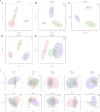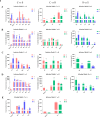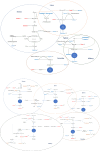Spatial regulation of chrysosplenetin on amino acid homeostasis linked to artemisinin resistance in Plasmodium berghei K173 based on targeted metabolomics
- PMID: 40258976
- PMCID: PMC12012018
- DOI: 10.1038/s41598-025-98409-x
Spatial regulation of chrysosplenetin on amino acid homeostasis linked to artemisinin resistance in Plasmodium berghei K173 based on targeted metabolomics
Abstract
Chrysosplenetin, a polymethoxy flavonol purified in our laboratory from the waste products generated during the industrial extraction of artemisinin, has been previously demonstrated to be a potential inhibitor of artemisinin resistance. Based on NMR-untargeted metabolomics, one of its hypothesized mechanisms of action is associated with the regulation of amino acid metabolism. In this study, we further quantified the key amino acids using LC-MS/MS targeted metabolomics and screened out the perturbed metabolic pathway network, which was characterized by tissue-specific differences. As a result, among the commonly and uniquely altered metabolites, increased levels of phenylalanine, tryptophan, and isoleucine were detected in the serum and various organs of the resistant groups. Interestingly, while the individual use of chrysosplenetin or artemisinin elevated the contents of these amino acids, their combination led to a significant down-regulation of these amino acids in the serum and intestines. Therefore, chrysosplenetin has the potential to act as a restorer of amino acid metabolism homeostasis, which is associated with artemisinin resistance in Plasmodium berghei K173.
Keywords: Amino acids; Artemisinin resistance; Chrysosplenetin; LC-MS/MS based targeted metabolomics; TMAO.
© 2025. The Author(s).
Conflict of interest statement
Declarations. Competing interests: The authors declare no competing interests. Ethical approval: The protocol was submitted to and approved by the University Ethics Committee (YXYLL-2021-10). Animal experiment: All experiment animals adhere to the ARRIVE guidelines.
Figures









Similar articles
-
Nontargeted metabolomics integrated with 1 H NMR and LC-Q-TOF-MS/MS methods to depict a more comprehensive metabolic profile in response to chrysosplenetin and artemisinin co-treatment against artemisinin-sensitive and -resistant Plasmodium berghei K173.Biomed Chromatogr. 2023 Mar;37(3):e5561. doi: 10.1002/bmc.5561. Epub 2022 Dec 30. Biomed Chromatogr. 2023. PMID: 36471489
-
Disordered Metabolic Profiling in Plasma and Tissues of Mice Infected with Artemisinin-Sensitive and -Resistant Plasmodium berghei K173 Determined by 1H NMR Spectroscopy.J Proteome Res. 2019 May 3;18(5):1970-1993. doi: 10.1021/acs.jproteome.8b00782. Epub 2019 Apr 11. J Proteome Res. 2019. PMID: 30931571
-
Antimalarial activity and sensitization of chrysosplenetin against artemisinin-resistant genotype Plasmodium berghei K173 potentially via dual-mechanism of maintaining host P-glycoprotein homeostasis mediated by NF-κB p52 or PXR/CAR signaling pathways and regulating heme/haemozoin metabolism.Phytother Res. 2023 Jul;37(7):2939-2956. doi: 10.1002/ptr.7789. Epub 2023 Mar 20. Phytother Res. 2023. PMID: 36938853
-
Considerations on the mechanism of action of artemisinin antimalarials: part 1--the 'carbon radical' and 'heme' hypotheses.Infect Disord Drug Targets. 2013 Aug;13(4):217-77. doi: 10.2174/1871526513666131129155708. Infect Disord Drug Targets. 2013. PMID: 24304352 Review.
-
Artemisinin resistance, some facts and opinions.J Infect Dev Ctries. 2015 Jul 4;9(6):597-9. doi: 10.3855/jidc.7015. J Infect Dev Ctries. 2015. PMID: 26142668 Review.
References
-
- Garrido-Cardenas, J. A., González-Cerón, L. & Manzano-Agugliaro, F. Mesa-Valle, C. genomics: an approach for learning about and ending human malaria. Parasitol. Res.118, 1–27. 10.1007/s00436-018-6127-9 (2019). - PubMed
-
- WHO. World malaria report 2020: 20 years of global progress and challenges. (2020). http://www.who.int/teams/global-malaria-programme
-
- WHO. Word malaria report 2021. (2021). https://www.who.int/teams/global-malaria-programme/reports/world-malaria...
-
- Duffy, P. E. & Sibley, C. H. Are we losing artemisinin combination therapy already? Lancet366, 1908–1909. 10.1016/S0140-6736(05)67768-9 (2005). - PubMed
MeSH terms
Substances
Grants and funding
LinkOut - more resources
Full Text Sources
Research Materials

